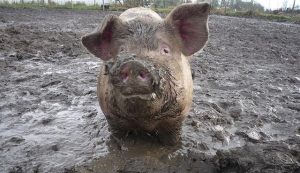I had a woman call me today who said she worked with one of my former students who was with me around 2000, and she said nice things about me – I was a tough asshole but she still said nice things about me.
 That’s the part I miss the most about being an ex-university professor, the students, and of course the hockey.
That’s the part I miss the most about being an ex-university professor, the students, and of course the hockey.
I do not miss faculty meetings.
I do miss Gonzo and Kate, people I worked with in the past, but nice to see them develop, and the little part I may have had in that. Chapman I don’t miss, because we talk every day ad e-mail each other about 10 times.
If Chapman gets accolades for bailing me out of jail, Gonzo gets full points for taking me to the hospital and waiting with me when I decided it might be a good idea to OD on booze when I lost my job (at the mall; I misplaced it).
Jen Sieve-Hicks of the Buffalo Bulletin, the best newspaper title I’ve heard in a long time, reports the Wyoming Department of Health has confirmed a salmonella outbreak caused by a pig or pigs at the Johnson County Fair.
After a number of Johnson County Fair participants fell ill with stomach cramps and diarrhea, the Department of Health requested stool samples from five people and was able to confirm that all five were suffering from the same type of salmonella.
According to the department’s surveillance epidemiologist Tiffany Greenlee, when two or more people get the same illness from contact with the same animal or animal environment, the event is called a zoonotic outbreak. Greenlee said the pathology reports indicate that the bacteria was transferred from animal to person via pig feces.
“Salmonella lives in animal intestines and is passed through excrement,” Greenlee said. “At fair, people are around their animals extensively – washing and feeding and grooming, and it’s pretty easy to get animal poop on your hands. We believe people got it from pig poop.”
Johnson County Fair Board President Laci Schiffer said that all animals exhibited at the fair undergo a health inspection before the opening of exhibits, and the fair has veterinarians on call the entire week of the fair should an animal appear ill.
Yeah, we’ve done this too: A table of petting zoo outbreaks is available at https://www.barfblog.com/wp-content/uploads/2017/08/Petting-Zoo-Outbreaks-Table-7-26-17.xlsx
Erdozain G, Kukanich K, Chapman B, Powell D.
Observation of public health risk behaviours, risk communication and hand hygiene at Kansas and Missouri petting zoos – 2010-2011. Zoonoses Public Health. 2012 Jul 30. doi: 10.1111/j.1863-2378.2012.01531.x. [Epub ahead of print]
Outbreaks of human illness have been linked to visiting settings with animal contact throughout developed countries. This paper details an observational study of hand hygiene tool availability and recommendations; frequency of risky behavior; and, handwashing attempts by visitors in Kansas (9) and Missouri (4), U.S., petting zoos.
Handwashing signs and hand hygiene stations were available at the exit of animal-contact areas in 10/13 and 8/13 petting zoos respectively. Risky behaviors were observed being performed at all petting zoos by at least one visitor. Frequently observed behaviors were: children (10/13 petting zoos) and adults (9/13 petting zoos) touching hands to face within animal-contact areas; animals licking children’s and adults’ hands (7/13 and 4/13 petting zoos, respectively); and children and adults drinking within animal-contact areas (5/13 petting zoos each). Of 574 visitors observed for hand hygiene when exiting animal-contact areas, 37% (n=214) of individuals attempted some type of hand hygiene, with male adults, female adults, and children attempting at similar rates (32%, 40%, and 37% respectively). Visitors were 4.8x more likely to wash their hands when a staff member was present within or at the exit to the animal-contact area (136/231, 59%) than when no staff member was present (78/343, 23%; p<0.001, OR=4.863, 95% C.I.=3.380-6.998). Visitors at zoos with a fence as a partial barrier to human-animal contact were 2.3x more likely to wash their hands (188/460, 40.9%) than visitors allowed to enter the animals’ yard for contact (26/114, 22.8%; p<0.001, OR= 2.339, 95% CI= 1.454-3.763). Inconsistencies existed in tool availability, signage, and supervision of animal-contact.
Risk communication was poor, with few petting zoos outlining risks associated with animal-contact, or providing recommendations for precautions to be taken to reduce these risks.
Best practices for planning events encouraging human-animal interactions
03.Apr.14
Zoonoses and Public Health DOI: 10.1111/zph.12117
G. Erdozain , K. KuKanich , B. Chapman and D. Powell
Educational events encouraging human-animal interaction include the risk of zoonotic disease transmission. It is estimated that 14% of all disease in the USA caused by Campylobacter spp., Cryptosporidium spp., Shiga toxin-producing Escherichia coli (STEC) O157, non-O157 STECs, Listeria monocytogenes, non-typhoidal Salmonella enterica and Yersinia enterocolitica were attributable to animal contact. This article reviews best practices for organizing events where human-animal interactions are encouraged, with the objective of lowering the risk of zoonotic disease transmission.
Keep it real.
Handwashing is never enough.
